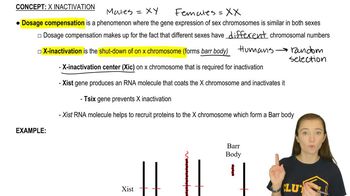Table of contents
- 1. Introduction to Genetics51m
- 2. Mendel's Laws of Inheritance3h 37m
- 3. Extensions to Mendelian Inheritance2h 41m
- 4. Genetic Mapping and Linkage2h 28m
- 5. Genetics of Bacteria and Viruses1h 21m
- 6. Chromosomal Variation1h 48m
- 7. DNA and Chromosome Structure56m
- 8. DNA Replication1h 10m
- 9. Mitosis and Meiosis1h 34m
- 10. Transcription1h 0m
- 11. Translation58m
- 12. Gene Regulation in Prokaryotes1h 19m
- 13. Gene Regulation in Eukaryotes44m
- 14. Genetic Control of Development44m
- 15. Genomes and Genomics1h 50m
- 16. Transposable Elements47m
- 17. Mutation, Repair, and Recombination1h 6m
- 18. Molecular Genetic Tools19m
- 19. Cancer Genetics29m
- 20. Quantitative Genetics1h 26m
- 21. Population Genetics50m
- 22. Evolutionary Genetics29m
2. Mendel's Laws of Inheritance
Sex-Linked Genes
Problem 19b
Textbook Question
Four eye-color mutants in Drosophila—apricot, brown, carnation, and purple—are inherited as recessive traits. Red is the dominant wild-type color of fruit-fly eyes. Eight crosses (A through H) are made between parents from pure-breeding lines.
Which of these eye-color mutants are X-linked recessive and which are autosomal recessive? Explain how you distinguish X-linked from autosomal heredity. <>
 Verified step by step guidance
Verified step by step guidance1
<span>Step 1: Understand the basic genetic concepts involved. In Drosophila, eye color is a trait that can be inherited in different ways. X-linked recessive traits are carried on the X chromosome, while autosomal recessive traits are carried on non-sex chromosomes (autosomes).</span>
<span>Step 2: Analyze the inheritance patterns. For X-linked recessive traits, males (XY) are more likely to express the trait because they have only one X chromosome. Females (XX) would need two copies of the recessive allele to express the trait. In contrast, autosomal recessive traits require two copies of the recessive allele in both males and females to be expressed.</span>
<span>Step 3: Examine the results of the crosses. Look for patterns where the trait appears more frequently in males than females, which would suggest X-linked recessive inheritance. If the trait appears equally in both sexes, it is likely autosomal recessive.</span>
<span>Step 4: Consider the parental genotypes. In pure-breeding lines, parents are homozygous for the trait. If a cross between a mutant and a wild-type results in all wild-type offspring, the mutant trait is likely recessive. If the trait reappears in the F2 generation, it confirms recessive inheritance.</span>
<span>Step 5: Use test crosses to confirm. Cross a mutant female with a wild-type male and observe the offspring. If the trait is X-linked recessive, all male offspring will express the trait. If the trait is autosomal recessive, the trait will appear in both sexes in the F2 generation.</span>
Recommended similar problem, with video answer:
 Verified Solution
Verified SolutionThis video solution was recommended by our tutors as helpful for the problem above
Video duration:
3mPlay a video:
Was this helpful?
Key Concepts
Here are the essential concepts you must grasp in order to answer the question correctly.
X-linked vs. Autosomal Inheritance
X-linked inheritance refers to traits associated with genes located on the X chromosome, while autosomal inheritance involves genes on non-sex chromosomes. In X-linked recessive traits, males (XY) are more likely to express the trait because they have only one X chromosome, whereas females (XX) can be carriers without showing the trait if they have one dominant allele.
Recommended video:
Guided course

X-Inactivation
Recessive Traits
Recessive traits require two copies of the recessive allele for expression in autosomal inheritance. In the case of X-linked traits, males only need one copy of the recessive allele on their single X chromosome to express the trait, while females need two copies on both X chromosomes. This difference is crucial for determining the inheritance pattern of the eye-color mutants.
Recommended video:
Guided course

Traits and Variance
Pure-breeding Lines
Pure-breeding lines consist of organisms that consistently produce offspring with the same phenotype when self-fertilized or crossed with each other. In the context of the Drosophila eye-color mutants, pure-breeding lines help establish the genetic basis of the traits, allowing researchers to determine whether the mutants are X-linked or autosomal by analyzing the offspring's phenotypes in controlled crosses.
Recommended video:
Guided course

Mendel's Experiments

 7:56m
7:56mWatch next
Master Sex-Linked Genes with a bite sized video explanation from Kylia Goodner
Start learningRelated Videos
Related Practice



